Low Calorie Dog Treats to Help with Weight Loss
October is recognized as National Pet Wellness Month, and even has a day specially dedicated for pet obesity awareness. It is important for dogs to maintain a nutritious diet and active lifestyle to ensure a long-lasting, healthy life. Dog obesity is one of the most common preventable health issues among canines of all breeds, so we’ll be looking at all things revolving around low calorie dog treats. Read on to learn more!
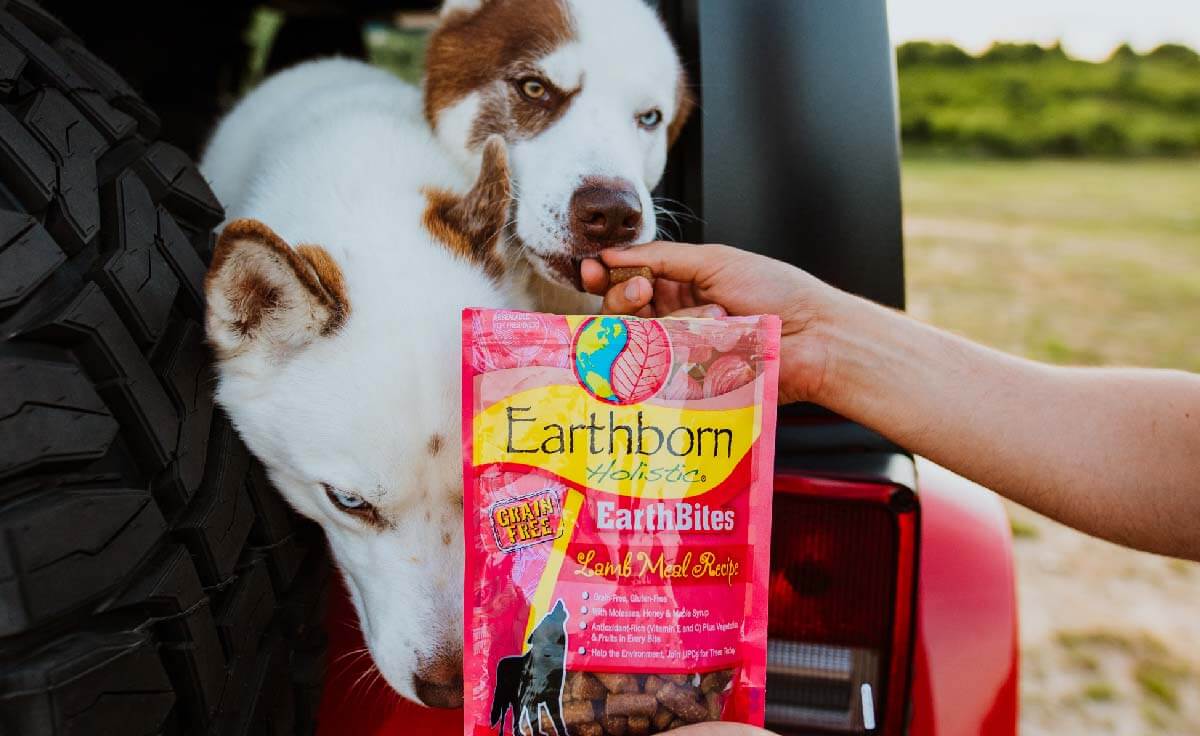
Low Calorie Dog Treats
It is important to take note of what is actually considered to be a low calorie dog treat. You may be wondering, “Are low calorie dog treats even actually healthy snacks for dogs?” Well, there are a number of factors to take into consideration to deem them as such. First and foremost, look at the ingredient list and general nutritional information on the dog treat packaging since this is ultimately the direct source. Knowing how to properly read a pet food label and understanding basic terminology will help you to better understand what is truly considered to be healthy for your pet.
All dog treats that comply with American Association of Feed Control Officials (AAFCO) standard include a guaranteed analysis section (in a similar manner to other pet food products). This section generally shows the minimum or maximum levels of nutrients including protein, fat, fiber, and moisture. Also included are any nutrients that are related to claims on the packaging. For example, our Oven Baked Biscuits are low fat biscuits and say “Low-Fat Treat” on the front of the packaging. Because of this, we’re required to list both the minimum and maximum fat content percentage in the guaranteed analysis, even though only the minimum is typically required.
Even if you do have low calorie dog treats, AKC notes that veterinarians everywhere recommend the ten percent rule. In other words, treats should not make up more than 10% of your dog’s diet. Therefore, you will need to take in account the amount of calories per treat from the dog treat label as well as your dog’s overall diet. It is also possible that the treats may be low in fat, but have high sugars or unnatural ingredients (including preservatives and additives in dog treats). Preservatives in dog treats or added colors are ingredients to stay clear of when looking for healthy low calorie dog treats.
After reviewing the ingredient list of the treat label and examining each of these factors, you should be able to determine if the selected low fat dog treats are really good snacks for dogs. We offer an assortment of dog treats to choose from with oven-baked and soft moist treat options.
Treats for Overweight Dogs
While a low fat diet is important to help with weight loss, it doesn’t end there. Weight loss dog food is just the first step when it comes to making sure your dog is happy and healthy for years to come. And while it’s common for dogs to experience issues with their weight, you should make sure you’re making a conscious effort to balance any decrease in activity that tends to happen as dogs age with a low fat diet.
Typically, weight gain becomes more of a problem as dogs age–seniors are more susceptible to a decrease in activity, which is why our Weight Control recipe is actually our recommended recipe for seniors. Seniors need a lower fat diet to combat less exercise, and limiting fat content is key to managing your dog’s weight. However, limiting fat also typically means limiting treats, too.
That being said, it is still possible to incorporate treats for older dogs! Our EarthBites grain-free soft dog treats are easy to break into smaller pieces, making them easy to feed senior dogs. Not to mention, they are packed with antioxidant-rich fruits, added vitamins and minerals, and are only 5-6 kcal per treat depending on the recipe, making them a great option low calorie option for weight control dog treats. Even better, soft treats are ideal for older dogs because they are easier for them to break down and digest.
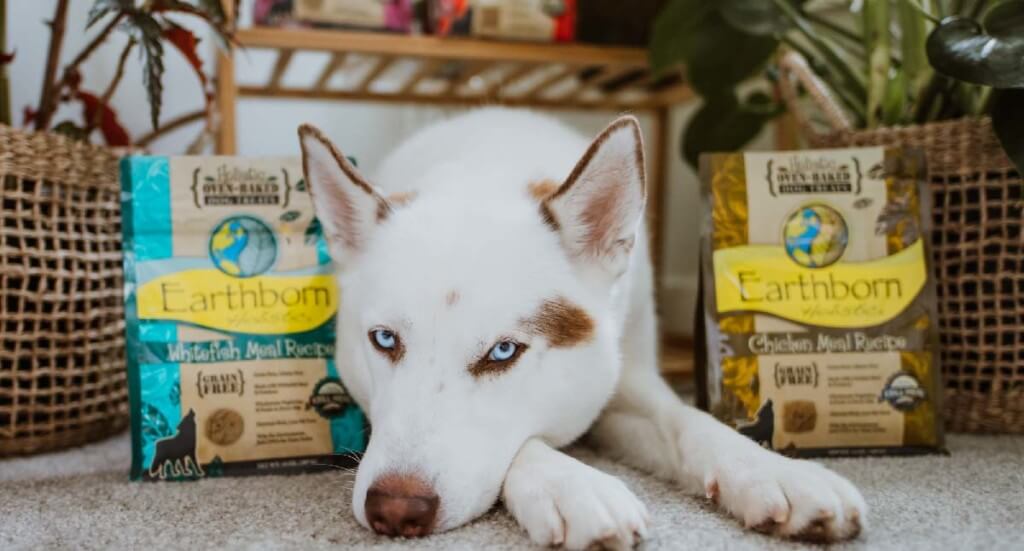
The excess weight that dogs tend to pack on as they get older can lead to a number of health problems. If your dog has packed on a little more weight than anticipated, it’s important for you to recognize how their extra weight can put extra stress on their joints. For this reason, supplements like glucosamine and chondroitin sulfate will be your dog’s best friend if they’re carrying a few extra pounds.
If you’re in the market for some nutrient-filled, high protein dog treats then look into trying our EarthBites Hip & Joint treats. Chondroitin sulfate and glucosamine found in these dog treats help maintain proper joint function and cartilage health. These tasty treats contain an antioxidant-rich formula full of lean turkey meal blended with wholesome vegetables and fruits. L-Carnitine in treats is also something to look for if you’re trying to help your dog lose weight as it helps move more fatty acids into cells to be burned for energy. If your food or treats do contain L-Carnitine, it’s usually listed in the guaranteed analysis.
Homemade Dog Treats
An alternative to our low calorie EarthBites soft grain-free dog treats is homemade dog treats. Making your own dog treats is a much more personal way for you to show your dog that you care. “The Cookie Rookie” shares a simple yet effective recipe for the classic DIY peanut butter dog treats. Peanut butter typically contains vitamins and healthy fats for your dogs, so it can be helpful with weight loss.
There are also organic dog treat recipes for homemade peanut butter dog treats. Peanut butter dog treats happen to be one of the easiest dog treat recipes to make. They just require mixing, rolling, and cutting which can be significantly healthier than many of the store bought options. This organic dog treat recipe requires four simple ingredients that you likely already have in your kitchen: pumpkin puree, peanut butter, eggs, and whole wheat flour.
With all of this talk of baking, you may be wondering if dogs can have all purpose flour. The answer is yes. However, some dogs may be allergic to ingredients in it, such as gluten. Though, there are other flour options that can be incorporated into homemade dog treats for allergies including whole wheat flour, coconut flour, and more.
If your dog usually deals with a lot of stomach issues, then there are also homemade dog treats for sensitive stomachs. These grain-free pumpkin dog treats from Smart Penny Pincher are a great option. Pumpkin is known for its great flavor and works as a prebiotic to help calm any upset tummies. This recipe also involves four easy ingredients: canned pumpkin, coconut flour, eggs, and chicken stock.
There are countless other homemade recipe options out there, including hypoallergenic dog treats. If you’re in a pinch and don’t have time to go to the store, you’re still able to find low calorie dog treats made of ingredients you already have at home!

Dog Treats to Avoid
So far, we have looked at healthy low calorie dog treats including Earthborn Holistic and homemade options. However, there are bad dog treats to be aware of, especially in regards to weight loss. It’s important to watch for high sugar content – you should limit feeding treats with too much sweetener. Dog Food Insider reports that synthetic chemical sweeteners, such as sorbitol, should be avoided because it leads to digestion issues, obesity, hypoglycemia, tooth decay, and more. Sorbitol in dog treats is often used to enhance flavors. (Note: Xylitol, similar to sorbitol, is a poisonous substance that is extremely dangerous for dogs. Seizures, clotting, or death may result from consumption.)
Rawhide
Why is rawhide bad for dogs? Rawhide is common among dog treats (more specifically dog chews). They are typically made of the inner parts of cow or horse hides. Some potential benefits of these include relieving anxiety, providing stimulation, and strengthening jaws. Yet, many dog owners question the use of rawhide in dog treats.
According to Pets Web MD, the most common rawhide risks are contamination, digestive irritation, and choking or blockages. Watch for toxic chemicals in these treats as they can potentially develop into Salmonella or E. coli contamination. Rawhides and edible chews of the sort can even lead to diarrhea problems. If choking or blockages arise, resolve as soon as possible. If the piece is small enough, your local vet may be able to assist in removal. Otherwise, abdominal surgery may be needed. These are serious matters as blockages can even result in death if not properly treated.
So is rawhide bad for dogs? Rawhide might not necessarily be the best treat option for the majority of dogs; especially when there are plenty of better alternatives. Recognize the associated risks and feed your dog what you see best fit and are most comfortable with.
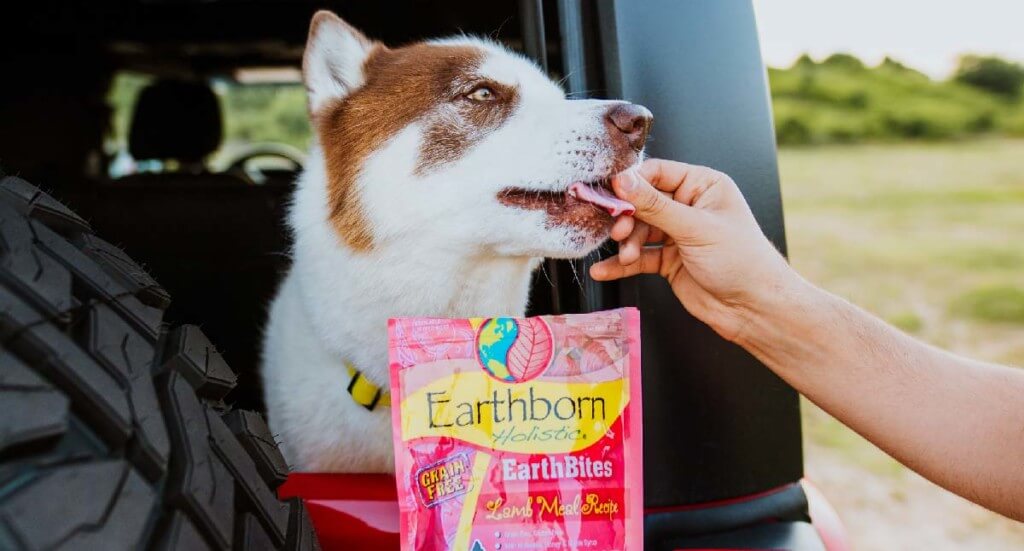
Too Many Treats
Then of course, how many dog treats is too many dog treats? The two most important things to look at when deciding is 1) your dog’s activity level and 2) the number of calories your dog consumes in a day. Remember the ten percent rule priorly mentioned? Treats typically should not make up more than 10% of a dog’s daily caloric intake. We happen to have a blog post with a complete focus on how many treats to give a dog per day. For more information – feel free to check it out!
When to Give Your Dog Treats
Every dog loves to hear the “T” word being exclaimed by their pet parent! Remember you are still able to give your dog treats, even if you are trying to enforce weight loss. If you’re feeling lost on when to give your dog treats, you can always ask your vet for the recommended feeding guidelines. They’ll be able to help you look at your dog’s food and determine how many treats you should feed based on that.
The answer to “how often should I give my dog treats?” varies, especially if it involves how much to feed an overweight dog. Treats should be more limited during their weight loss journey, but they are still able to enjoy the low fat and low calorie dog treats that we’ve mentioned.
Knowing when to use high-value dog treats is essential to helping your dog throughout its course of life. As most dog parents would anticipate, treats can and in fact should be used to reward good behavior dog training. High-value dog treats should be used sparingly, moreso for learning new or difficult tasks as well as challenging situations.
Another circumstance that is suitable to give your dog treats is if they begin to feel stress. Everyone wants a calm dog, and there just so happens to be dog treats that specifically aid with this. Calming dog treats can help with dogs who may be experiencing hyper-activity or anxiety, more specifically separation anxiety. Separation anxiety tends to occur when dogs are separated from their owner for too long. These kinds of treats can be used in an attempt to relieve feelings like this before relying on any prescriptions.
There are a number of instances where you may feel it is appropriate to give your dog treats. It’s important to take into consideration their health and benefits from the treats. As always, if you have any further concerns, be sure to consult with your vet.
Training Treats
Now that we have looked at some situations for when to give your dog treats, let’s dive deeper into training treats. One of the most common ways to use treats is for training purposes. Deciding the right treat for your dog will ultimately result in the best reward for you and them both. So… how do you go about choosing? There are a variety of dog training treats out there – let’s take a look at some of the most recommended options.
As mentioned earlier, high value dog treats will soon be your best friend – especially if you are a beginner at dog training. Your dog is going to need something to motivate them to want to learn certain tricks or behaviors. Therefore, high value treats are typically used in order to get them to want to focus and repeat the desired tasks or challenges at hand. High value dog treats are treats that your dog doesn’t get often. For example, small pieces of chicken or a spoon of peanut butter (as long as it doesn’t contain xylitol) could be used.
Earthborn Holistic grain-free dog treats are available in resealable bags to keep freshness and make for a fun and healthy training reward for your dog or puppy. Grain-free training treats are an excellent choice for any dogs who may be allergic to grains. Additionally, our dog treats happen to be gluten free. Grain-free and gluten-free diets for dogs are becoming more and more popular nowadays. Gluten-free training treats are designed for dogs that experience gluten intolerances or sensitivities and if your dog has either a grain or gluten allergy, all of our dog treats are both grain- and gluten-free!
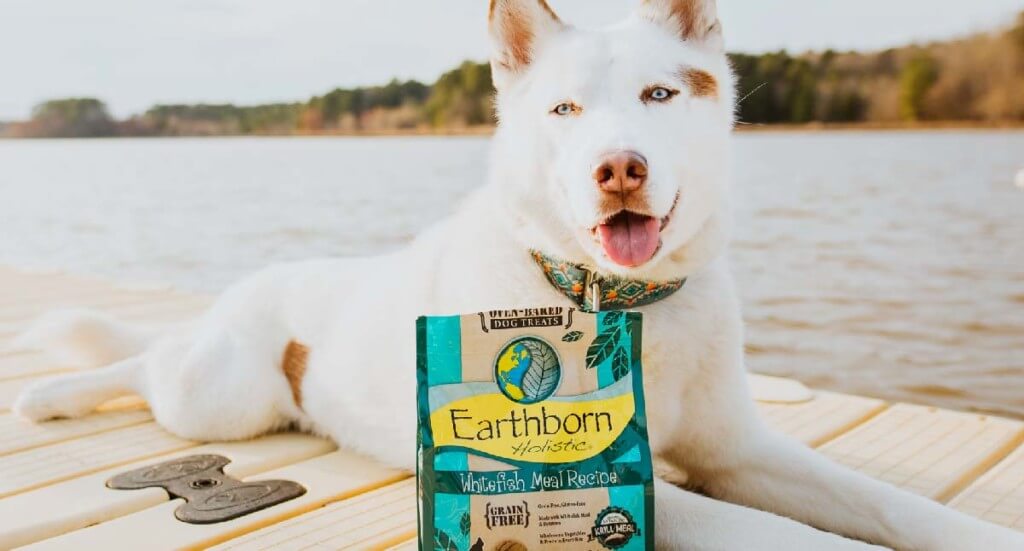
Soft dog treats are a perfect way to get your dog’s attention! Our Earthbites grain-free soft dog treats can be easily broken into smaller pieces making them great soft training treats. Not to mention, they are packed with antioxidant-rich fruits and veggies and added vitamins and minerals to make for a perfect, healthy snack.
Small dog treats are suggested for smaller breeds, and even larger breeds. Smaller pieces generally help to keep the training session flow more smoothly and efficiently. The American Kennel Club (AKC) advises pea-sized treats or even smaller pieces. It’s important to remember calories involved especially when it comes to puppies or dogs training for specific sports. Small dog treats will help to keep the number of calories consumed while still providing them with the necessary motivation. Dogs should be fine with smaller portions if you are using a treat that they love.
Natural dog treats are not only another great option for training treats but will likely be considered low calorie dog treats as well. For example, our Oven Baked treats are all natural treats with added vitamins, minerals, and probiotics for a low-fat, healthy snack. Training treats are vital to keep your dogs interested in the process. Hopefully, you feel more comfortable finding a training treat option that you and your furry friend can benefit from.
How to Stop a Dog from Begging
Once your dog finds a treat that they love, they may start to feel like they can’t get enough of it. Treats are typically used to reward good behavior, however there’s a chance you will have some four-legged beggars in your household. So, you might be wondering how to stop a dog from begging.
You must consider the question: why do dogs beg for food? Once you recognize all the factors that contribute to begging, you can begin to make the proper adjustments. For starters, feed your dog first. If your dog is well-fed, there is less of a chance that they will beg for food. Take notice of your dog’s eating habits, such as them not finishing their meals or losing interest in their dog food.
Then, you may want to look into switching your dog’s diet and finding a new recipe that better works for them. There are plenty of nutritious dog food recipes that are sure to satisfy their taste buds. You can always try dog food for weight control to help keep your dog healthy and fit by reducing fat without reducing the necessary nutrients your pup needs. Earthborn Holistic Weight Control is enriched with Taurine for heart health and is crafted without peas, lentils, or legumes. An added blend of superfoods like pumpkin, blueberries, carrots and apples are the perfect addition to this low-fat dog food recipe that will help keep your dog fuller, longer.
If solely feeding your dog first doesn’t quite hinder the begging situation, you may want to consider distancing your dog at the dinner table. In other words, make it to where your dog is unable to access the table. This can be done by using pet gates or crates during dinner time until they learn the behavior on their own.
You should always be aware of foods toxic to dogs which can commonly be found at the dinner table. Just because certain foods are good for humans doesn’t necessarily mean they are for dogs. In fact, many human foods are not intended for dogs and can actually be poisonous. The Humane Society of the United States provides a lengthy list of some of the most common foods that can be poisonous to pets. Some foods include avocados, grapes, coffee, chocolate, xylitol, garlic, and more. If consumed, you should consult with your vet or a pet nutritionist right away. This is all the more reason why you should feed dogs in separate rooms.
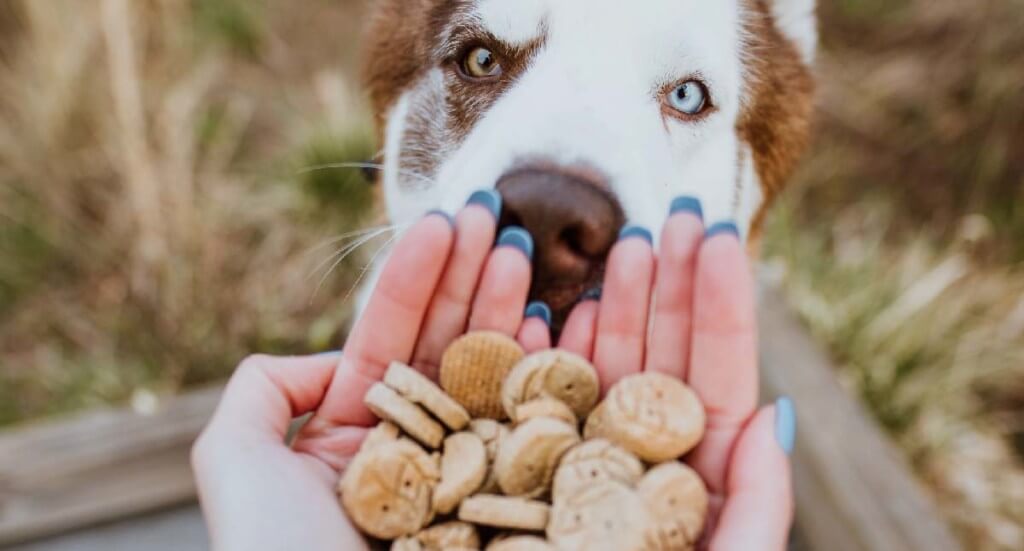
We see how treats are used to reward good behavior, so they can also be used to redirect behavior. It’s important to not give into the begging or any sort of “puppy dog eyes” that may be involved at the dinner table. As soon as you fall for it, they are likely to think that they will be able to get away with this behavior again. With that being said, you may need to lightly scold them so they know that this kind of behavior is not okay. It also helps to provide them with distractions so that they stay busy during dinner time. This way they won’t be focused on you and your food. Try providing them with fun, challenging treat toys or puzzles.
Multiple methods can be implemented to stop dogs from begging. These efforts addressed above plus basic obedience skills will get your dog to have good table manners in no time!
Alternatives to Dog Treats
At the end of the day, every pet parent just wants to build a strong and loving relationship with their dog. This is all still possible without the use of dog treats, even if training treats are particularly useful for learning basic commands and tricks. Once they have learned these behaviors, feel free to reduce dog treats in their diet to keep them in shape.
Pet parents are expected to provide opportunities for their dogs to achieve fulfillment. You should reward with toys to reduce any feelings of boredom or anxiety they may feel over their lifetime. Enrichment toys are perfect for pups to interact and engage with, in turn creating a happy and stimulating environment for them to enjoy. If you’re trying to wean your dog off treats but they don’t have a strong love for toys, consider building up their toy drive to help make the transition easier on them.
Spending quality time or simply giving attention will lead to better communication and forming a better overall bond. Playing with your dog for as little as ten minutes a day will even help fulfill them physically and mentally to help them feel healthy and happy. If you have the time and feel like going above and beyond, try doing dog sports or group classes together. These are great ways to really connect with your dog, as well as other fellow dog lovers! Life rewards us with the chance to bond with these amazing creatures, so why not make the most out of it?




